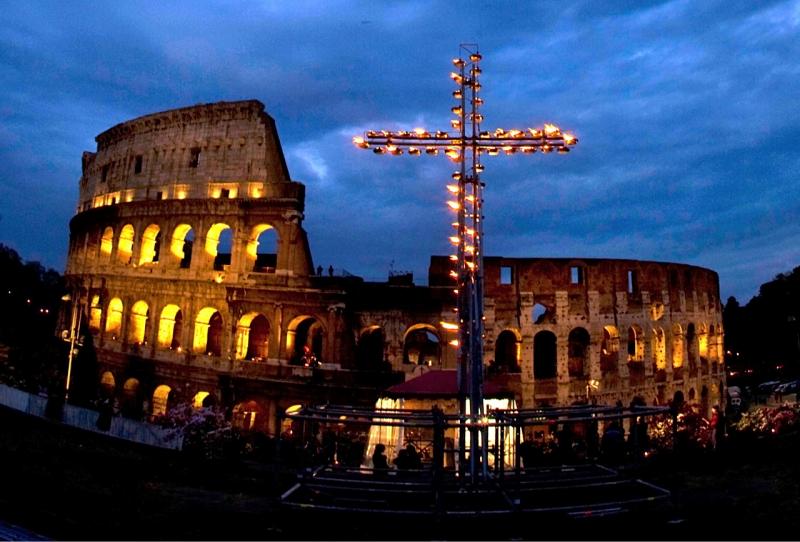The Via Crucis devotion (Stations of the Cross or Way of the Cross) has been practiced by Roman Catholics for many centuries. It commemorates the passion and death of Jesus Christ through the reading of prayers along a path of 14 stations. The tradition as chapel devotion began with St. Francis of Assisi and extended throughout the Roman Catholic Church in medieval times.
Today, the Stations of the Cross can be found in almost every Catholic Church and, although it can be done at any time, it is most common during the Season of Lent, on Friday evenings and, especially, on Good Friday.
In Rome, on Good Friday, there is a traditional Via Crucis taking place at the Colosseum. This tradition goes back to the 18th century during Pope Benedict XIV’s pontiff, and was revived in 1964 by Pope Paul VI.
With Pope John Paul II, the annual public Good Friday prayer of the Stations of the Cross at the Roman Colosseum became also a worldwide television event.
Originally, the Pope himself carried the cross from station to station, but in his last years, when age and infirmity limited his strength, John Paul presided over the celebration from a stage on the Palatine Hill, while others carried the cross. Just days prior to his death in 2005, Pope John Paul II observed the Stations of the Cross from his private chapel.
Every year, a different person is invited to write the meditation texts for the Stations. Past writers of the Papal Stations include several non-Catholics. The Pope himself wrote the texts for the Great Jubilee in 2000.
This is the second year Pope Francis will lead the traditional Via Crucis on Good Friday at the Colosseum in Rome and the event will be broadcast worldwide. The meditation texts were prepared by Archbishop Giancarlo Maria Bregantini of Campobasso-Boiano, chairman of the CEI (Conferenza Episcopale Italiana), a Vatican commission for issues regarding social welfare, employment, justice and peace.
Significantly, the news of the assignment was given at the end of March, just a few days after the Pope's meeting with the Libera Association, an NGO which supports the victims of mafia all over Italy. In fact, Msgr Bregantini, during his previous episcopate in Locri-Gerace in Calabria, structured his pastoral mission around the fight against all forms of organized crime.
The evening Via Crucis procession at the ancient Colosseum amphitheater is a Rome tradition that draws a large crowd of faithful, including many of the pilgrims who flock to the Italian capital for Holy Week ceremonies before Easter Sunday.
It is a very interesting event even for those who are not Catholic and, if you happen to be in Rome this week, do not miss the mystical atmosphere around the Colosseum on Friday evening.
You can find the booklet to follow the Via Crucis 2014 here.
The ceremony will be broadcast online on the Vatican's official website, www.vatican.va, and on the Radio Vaticana website www.radiovaticana.org, and starts at 9pm CET.
Information on Worldwide Telecasts is available here.
Below is a video of the 2013 Station of the Cross at the Colosseum:











